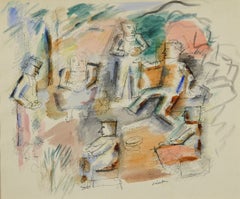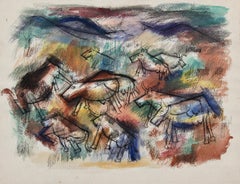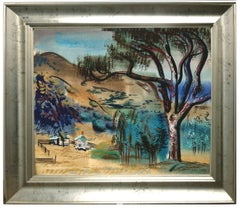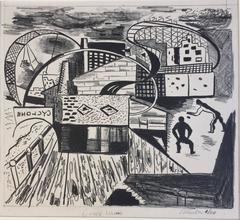Louis Schanker Art
to
8
8
8
5
2
1
Untitled
By Louis Schanker
Located in Lawrence, NY
Louis Schanker was an important early American modernist painter. He was best known for his work of the 30's and 40's done in a semi-abstract mode that was influenced by European m...
Category
1930s Abstract Louis Schanker Art
Materials
Oil
St. George & the Dragon
By Louis Schanker
Located in Raleigh, NC
An American modernist depiction of St. George slaying the dragon in blue. There is also another version in yellow on a black background.
Category
1940s American Modern Louis Schanker Art
Materials
Woodcut
FIGURE NO. 1
By Louis Schanker
Located in Portland, ME
Schanker, Louis (American 1903-1981). FIGURE NO.1. Johnson 99. Wood etching in colors, 1949. Edition of 6. Titled and signed in pencil. 25 1/2 X 13 3/8 inches (image). Framed to 33...
Category
1940s Louis Schanker Art
Materials
Woodcut
CAFE NO. 1
By Louis Schanker
Located in Portland, ME
Schanker, Louis (American 1903-1981). CAFE NO.1. Johnson 14. Woodcut in colors, 1938. Edition of 35. Titled, numbered 8/35 and signed in pencil. 9 x 5 1/2 inches (image), plus marg...
Category
1930s Louis Schanker Art
Materials
Woodcut
Interior Scene with Figures
By Louis Schanker
Located in Fairlawn, OH
Interior Scene with Figures
Ink and watercolor on paper, c. 1930's
Signed with the Estate stamp lower center
Condition: Loss upper right corner; two small tears lower margin
Colors very fresh and vibrant
Provenance: Jem Hom Gallery, Washington, D.C.
Martin Dimanond Fine Arts, NYC (?)
Louis Schanker (1903–1981)[1] was an American abstract artist.
"He grew up in an Orthodox Jewish environment in the Bronx, New York. His parents, Sam, a tailor, and Fannie Schanker, were of Romanian descent.[2] He had five siblings.[3] At an early age he had an interest in both art and music He took art courses at Cooper Union, The Educational Alliance and The Art Students League with Barnett Newman, Mark Rothko and Milton Avery amongst others. During this time he shared a coldwater studio with the Soyer brothers, Chaim Gross and Adolph Gottlieb. In 1920 he traveled across the country. He lived the hobo life, joined the Sparks and then Barnum and Bailey circuses, later working as a thresher in the wheat fields of the Great Plains. There are elements in his works such as the circus murals...
Category
1930s American Modern Louis Schanker Art
Materials
Watercolor
Cows in a Field (Recto) Two Figures in an Interior (Verso)
By Louis Schanker
Located in Fairlawn, OH
Cows in a Field (Recto)
Two Figures in an Interior (Verso)
Watercolor on heavy textured paper, 1938
Signed in ink verso image of Two Figures, unsigned ...
Category
1930s American Modern Louis Schanker Art
Materials
Watercolor
GIRL WITH LUTE
By Louis Schanker
Located in Portland, ME
Schanker, Louis (American 1903-1981). GIRL WITH LUTE. Johnson 18. Linocut in colors, 1938. Edition of 10. Titled, numbered 6/10 and signed in pencil. 5 1/2 x...
Category
1930s Louis Schanker Art
Materials
Linocut
CIRCLE IMAGE NO. 25
By Louis Schanker
Located in Portland, ME
Schanker, Louis. CIRCLE IMAGE NO. 25. Relief Print in color, 1954-1955. Edition of 210 published by IGAS. Signed and numbered 17/200 (the edition included 10 artist's proofs). 14 x 1...
Category
1950s Abstract Louis Schanker Art
Materials
Woodcut
Related Items
Shunga - Woodcut by Katsukawa Schuncho - Mid-18th Century
By Katsukawa Shunshō
Located in Roma, IT
Shunga is an original modern artwork realized by Katsukawa Schuncho (1726 – 1793) in the half of the 18th Century.
Erotic scene from the series "Koshuko zue juni ko".
A courtesan with a customer under a kimono stand...
Category
Mid-18th Century Modern Louis Schanker Art
Materials
Paper, Woodcut
H 7.88 in W 11.82 in D 0.04 in
1940's California Hills Landscape
By Erle Loran
Located in Soquel, CA
Substantial and period mid-century modern American Scene watercolor of the Oakland, California countryside by Erle Loran (American, 1905-1999), 1944. Signed lower right "Earl Loran...
Category
1940s American Modern Louis Schanker Art
Materials
Watercolor, Archival Paper
Fires of Spring in Big Woods
By Charles E. Burchfield
Located in New York, NY
Estate stamp lower right
Category
20th Century American Modern Louis Schanker Art
Materials
Pencil, Watercolor
Original Color Field Oil Painting Multi-Color Geometric Abstract - "Commute"
By Virginia Sevier Rogers
Located in Soquel, CA
Original Color Field Oil Painting Multi-Color Geometric Abstract - "Commute"
Dramatic multi-color geometric abstract painting by Virginia Sevier Rogers (American, 1917-2015). Vivid ...
Category
1960s Abstract Louis Schanker Art
Materials
Canvas, Oil
'The Aquarium' — WPA Era 1930s Graphic Modernism
By Fritz Eichenberg
Located in Myrtle Beach, SC
Fritz Eichenberg, 'The Aquarium', wood engraving, 1933, edition 200. Signed and titled in pencil. Initialed in the block, lower right. A superb, richly-inked impression, on pale yel...
Category
1930s American Modern Louis Schanker Art
Materials
Woodcut
'Mountain Climber' — 1930s American Modernism
By Rockwell Kent
Located in Myrtle Beach, SC
Rockwell Kent, 'Mountain Climber', wood engraving, 1933, edition 250, Burne Jones 93. Signed in pencil. A brilliant, black impression, on cream, wove Japan paper; the full sheet with margins (2 9/16 to 3 5/8 inches); slight skinning at the top sheet edge verso, where previously hinged; otherwise, in excellent condition. Archivally matted to museum standards, unframed.
Image size 7 7/8 x 5 7/8 inches (200 x 149 mm); sheet size 14 x 11 1/8 inches (356 x 283 mm).
Printed by Pynson Printers, New York. Distributed by The Print Club of Cleveland, Publication No. 11, 1933.
Literature: 'Rockwellkentiana,' Harcourt, Brace and Company, New York, 1933. '101 of The World’s Greatest Books', edited by Spencer Armstrong, 1950.
Impressions of this work are held in the following museum collections: Akron Art Institute, Burne Jones Collection, IL; Cincinnati Art Museum; Cleveland Museum of Art; Columbus Gallery of Fine Arts; Crystal Bridges Museum of American Art; Davis Museum at Wellesley College; Fine Art Museums of San Francisco; H. M. de Young Museum; Hermitage Museum; Kent Collection, NY; Library of Congress; Memorial Art Gallery, University of Rochester; Metropolitan Museum of Art; New York Public Library; Philadelphia Museum of Art; Princeton University Library; Smithsonian American Art Museum, Spector Collection, NY; SUNY, Plattsburg.
ABOUT THE ARTIST
Rockwell Kent (1882-1971), though best known as a painter, graphic artist, and illustrator, pursued many careers throughout his life, including architect, carpenter, explorer, writer, dairy farmer, and political activist. Born in Tarrytown, New York, Kent was interested in art from a young age. These ambitions were encouraged by his aunt Jo Holgate, an accomplished ceramicist. Jo came to live with the family after Kent’s father passed away in 1887 and took him to Europe as a teenager, undoubtedly kindling his interest in exploring the world.
Kent attended the Horace Mann School in New York City, where he excelled at mechanical drawing. His family’s financial circumstances prevented him from pursuing a career in the fine arts; however, after graduating from Horace Mann in 1900, Kent decided to study architecture at Columbia University.
Before matriculating at Columbia, Kent spent the first of three consecutive summers studying painting at William Merritt Chase’s art school in Shinnecock Hills, Long Island. There he found a community of mentors and fellow students who encouraged him to pursue his interest in art. At the end of Kent’s third summer at Shinnecock, Chase offered him a full scholarship to the New York School of Art, where he was a teacher. Kent began taking night classes at the art school in addition to his architecture studies but soon left Columbia to study painting full-time. In addition to Chase, Kent took classes with Robert Henri and Kenneth Hayes Miller, where his classmates included the artists George Bellows and Edward Hopper.
Kent spent the summer of 1903 assisting the eccentric painter Abbott Handerson Thayer at his studio in Dublin, New Hampshire—a position he secured through the recommendation of his Aunt Jo. Thayer’s naturalist lifestyle and almost mystical appreciation for natural phenomena greatly influenced Kent; he returned to Dublin for many years to visit Thayer and his family. Thayer gave the young artist time to pursue his work, and that summer Kent painted several views of the New Hampshire landscape, including Mount Monadnock. In 1905 Kent moved from New York to Monhegan Island in Maine, home to a summer art colony, where he continued to find inspiration in nature. Kent soon found success exhibiting and selling his paintings in New York, and in 1907, he was given his first solo show at Claussen Galleries. The following year he married his first wife, Kathleen Whiting (Thayer’s niece), with whom he had five children. The couple divorced in 1924, and Kent married Frances Lee the following year. They divorced after 15 years of marriage, and the artist married Sally Johnstone.
For the next several decades, Kent lived a peripatetic lifestyle, settling in several locations in Connecticut, Maine, and New York. During this time he took several extended voyages to remote, often ice-filled, corners of the globe, including Newfoundland, Alaska, Tierra del Fuego, and Greenland, to which he made three separate trips. For Kent, exploration and artistic production were twinned endeavors, and his travels to these rugged, elemental locations inspired his visual art and his writings. He developed a stark, realist landscape style in his paintings and drawings that revealed both nature’s harshness and its sublimity. Kent’s human figures, which appear sparingly in his work, often allude to the mythic themes of isolation, individualism, heroism, and the quest for self-connection. Important exhibitions of works from these travels include the Knoedler Gallery’s shows in 1919 and 1920, featuring Kent’s Alaska drawings...
Category
1930s American Modern Louis Schanker Art
Materials
Woodcut
African American Woman artist Mailou Jones Cezannian Cote d'Azur cubist village
Located in Norwich, GB
If you are interested in African American Art and in Women in the Arts, I will certainly not need to introduce Lois Mailou Jones (1905-1988). Often associated with the Harlem Renaiss...
Category
Mid-19th Century American Modern Louis Schanker Art
Materials
Watercolor, Gouache, Handmade Paper
H 29.93 in W 25.79 in D 1.19 in
Colorado Mountain Winter Landscape Watercolor Painting, Blue, Orange, Purple
Located in Denver, CO
Colorado mountain landscape watercolor painting signed by artist Rita Derjue (1934-2020) depicts Cabins in the Snow in bright tones of blue, yellow, green and red/brown. Signed by the artist in the lower right corner. Presented in a custom frame with archival materials, outer dimensions measure 24 ⅛ x 31 ½ x 1 ¼ inches. Image sight size is 14 ½ x 21 ½ inches.
About the Artist:
Born Rhode Island, 1934
Artist, educator, mentor and community activist, Derjue is the daughter of European parents whose family members had previous connections with New York and New England. Her drawing talent as a youngster in Rhode Island caught the attention of family friend Johann Groen, a Dutch-born painter and photographer, who encouraged her to spend time touring and studying in Europe to further her art education.
In 1956 she earned her Bachelor of Fine Arts degree at the Rhode Island School of Design that emphasized the fundamentals of drawing and design. Her most memorable teacher was Richard Hamilton, whose work was influenced by German Expressionist Max Beckmann and the jazz greats. Her studies from nature and Cubist compositions done at that time reflect her interest in early twentieth-century European modernist painting. She had the opportunity to experience it firsthand during a year of post-graduate work at the renowned Akademie den Bildenden Kunste in Munich, Germany, in 1956-57. She studied with Ernest Geitlinger (1895-1972) whom the Nazi government classified as a “degenerate” artist in the 1930s, preventing him from exhibiting in Germany. After World War II he was one of the co-founders of the Munich artists’ association, Neue Gruppe, in 1946 and played an important role in abstract painting.
While studying with him in Munich she produced a number of canvases in a referential abstract style. She also became acquainted with the Blaue Reiter group that flourished in the early twentieth century and whose expressionism strongly influenced her color palette and painting style. She particularly admired the work of Blaue Reiter co-founder and Wassily Kandinsky’s long-time partner, Gabriele Münter, whose work she studied at the Lenbachhaus in Munich and at the Gabriele Münter Haus and the Schlossmuseum in Murnau south of Munich. Derjue’s immersion in German Expressionism imparted a bold, simplified style to her work.
In 1958 with a friend from Munich she went to Mexico for a year, studying with artist Frank Gonzalez in his studio in San Angel, Mexico City, and with Canadian artist, Toni Onley, in San Miguel de Allende. Onley had recently won a scholarship to the Instituto Allende to study mural and fresco painting with David Siqueiros, one of the three greats of Mexican muralism. At the Instituto Onley began painting large black-and-white canvases in an abstract impressionistic style which he imparted to Derjue, who thereafter began exploring color and space in the dimensions of her own large compositions. With writer Gregory Strong, he subsequently published Onley’s Arctic and his autobiography, The Tony Onley Story.
After returning to the United States, she worked as a graphic designer for Little, Brown and Company, publishers in Boston. She began dating her future husband, Carle Zimmerman, whom she met earlier in Europe and whom she married in 1960. Joining him at Cornell University where he was completing his Ph.D degree, she earned her Master of Arts degree at the same institution and participated in group shows at the Herbert F. Johnson Museum and the Munson-Williams-Proctor Arts Institute in upstate New York. In 1963 Derjue and her husband relocated to Littleton, Colorado, where he spent his entire career, first as a research engineer and later as a departmental manager for the Marathon Oil...
Category
20th Century American Modern Louis Schanker Art
Materials
Watercolor, Archival Paper
H 24.25 in W 31.5 in D 1.25 in
'City Lights' — Vintage Wood Engraving, New York City, 1934
By Fritz Eichenberg
Located in Myrtle Beach, SC
Fritz Eichenberg, 'City LIghts', wood engraving, 1934, edition 200. Signed, titled 'Lights', and annotated 'No 2/200 for Howard M. Chapin' in pencil. Initialed in the block, lower right. A fine, richly-inked black impression, on cream wove paper, with full margins (1 1/4 to 1 7/8 inches); a small loss (5/8 inch) in the top right sheet corner, well away from the image, otherwise in excellent condition. Printed by master printer Ernest Roth...
Category
1930s American Modern Louis Schanker Art
Materials
Woodcut
'Taos Placita' — 1940s Southwest Regionalism
By Gustave Baumann
Located in Myrtle Beach, SC
Gustave Baumann, 'Taos Placita', color woodcut, 1947, edition 125. Baumann 132. Signed, titled, and numbered '20-125' in pencil; with the artist’s Hand-in-Heart chop. A superb, richly-inked impression, with fresh colors, on fibrous oatmeal wove paper; the full sheet with margins (2 to 3 1/8 inches); slight rippling at the left sheet edge, in excellent condition. Matted to museum standards, unframed.
Image size 9 5/8 x 11 1/4 inches (244 x 286 mm); sheet size 13 1/4 x 17 inches (337 x 432 mm).
Collections: New Mexico Museum of Art, Phoenix Art Museum, Wichita Art Museum.
ABOUT THE ARTIST
Gustave Baumann (1881-1971) was a renowned printmaker and a leading figure of the American color woodcut revival whose exquisite craftsmanship and vibrant imagery captured the essence of the Southwest.
"A brilliant printmaker, Baumann brought to the medium a full mastery of the craft of woodworking that he acquired from his father, a German cabinetmaker. This craftsmanship was coupled with a strong artistic training that resulted in the handsome objects we see in the exhibition today. After discovering New Mexico in 1918, Baumann began to explore in his woodblock prints of this period the light. color, and architectural forms of that landscape. His prints of this period are among the most beautiful and poetic images of the American West."
—Lewis I. Sharp, Director, Denver Art Museum
Baumann, the son of a craftsman, immigrated to the United States from Germany with his family when he was ten, settling in Chicago. From 1897 to 1904, he studied in the evenings at the Art Institute of Chicago, working in a commercial printmaking shop during the day. In 1905, he returned to Germany to attend the Kunstwerbe Schule in Munich, where he decided on a career in printmaking. He returned to Chicago in 1906 and worked for a few years as a graphic designer of labels.
Baumann made his first prints in 1909 and exhibited them at the Art Institute of Chicago the following year. In 1910, he moved to the artists’ colony in Nashville, Indiana, where he explored the creative and commercial possibilities of a career as a printmaker. In 1915, he exhibited his color woodcuts at the Panama-Pacific International Exposition in San Francisco, winning the gold medal.
Among Baumann’s ongoing commercial activities was his work for the Packard Motor Car Company from 1914 to 1920 where he produced designs, illustrations, and color woodcuts until 1923.
In 1919, Baumann’s printmaking work dominated the important exhibition of American color woodcuts at the Detroit Institute of Arts. Twenty-six of his prints were included, far more than the works of any other artist. A set of his blocks, a preparatory drawing, and seven progressive proofs complemented the exhibition. That same year, Baumann worked in New York and, over the summer, in Provincetown, Massachusetts. His airy images of Cape Cod employed soft, pastel colors and occasionally showed the influence of the white-line woodcut technique.
Many of his Chicago artist friends had traveled to the southwest, and Baumann became intrigued by their paintings, souvenirs, and stories of an exotic place named Taos, New Mexico. In the summer of 1918, he spent the summer in Taos sketching and painting before visiting Santa Fe. Paul Walter, the director of the Museum of New Mexico, offered him a studio in the museum's basement. Inspired by the rugged beauty of the Southwest—the vibrant colors and dramatic landscapes of the region became a central theme in his work, influencing his artistic style and subject matter for the remainder of his career. Later in the decade, he traveled to the West Coast and made prints of California landscape.
Baumann's prints became synonymous with the Southwest, capturing the spirit of its place in America's identity with a unique sense of authenticity and reverence. His iconic images of desert vistas, pueblo villages, and indigenous cultures served as visual tributes to the region's rich cultural heritage, earning him a dedicated following among collectors and curators alike.
A true craftsman and artist, Baumann completed every step of the printmaking process himself, cutting each block, mixing the inks, and printing every impression on the handmade paper he selected. His dedication to true craftsmanship and his commitment to preserving the integrity of his artistic vision earned him widespread acclaim and recognition within the art world. About the vibrant colors he produced, Baumann stated, “A knowledge of color needs to be acquired since they don’t all behave the same way when ground or mixed...careful chemistry goes into the making of colors, with meticulous testing for permanence. While complicated formulae evolve new colors, those derived from Earth and metal bases are still the most reliable.”
In the 1930s, Baumann became interested in puppet theater. He designed and carved his own marionettes and established a little traveling company. From 1943 to 1945, the artist carved an altarpiece for the Episcopal Church of the Holy Faith in Santa Fe. In 1952, a retrospective exhibition of his prints was mounted at the New Mexico Museum of Fine Arts. Throughout his prolific career, Baumann executed nearly four hundred color woodcuts.
Baumann’s woodcuts...
Category
1940s American Modern Louis Schanker Art
Materials
Woodcut
'The Steps' — WPA Era 1930s Graphic Modernism
By Fritz Eichenberg
Located in Myrtle Beach, SC
Fritz Eichenberg, 'The Steps', wood engraving, 1933, edition 200. Signed, titled, and annotated 'Ed. 200' in pencil. Initialed in the block, lower right. A superb, richly-inked impr...
Category
1930s American Modern Louis Schanker Art
Materials
Woodcut
Max Weber Woodcut Print from "Primitives" Poetry Book Signed
By Max Weber
Located in Detroit, MI
ONE WEEK ONLY SALE
This woodcut print is an expressionist print on one of the poems from Max Weber's poetry collection "Primitives: Poems and Woodcuts". This work is signed in penci...
Category
1920s Expressionist Louis Schanker Art
Materials
Woodcut
Previously Available Items
CYCLONE, CONEY ISLAND ca 1933
By Louis Schanker
Located in Santa Monica, CA
LOUIS SCHANKER (1903 – 1981)
CYCLONE, CONEY ISLAND ca 1933
Lithograph 10 7/8 x 12 ½” signed, and with no. 1/10. Rare thus!
Annotation: Coney Island. ...
Category
1930s American Modern Louis Schanker Art
Materials
Lithograph
Louis Schanker art for sale on 1stDibs.
Find a wide variety of authentic Louis Schanker art available for sale on 1stDibs. You can also browse by medium to find art by Louis Schanker in woodcut print, paint, watercolor and more. Much of the original work by this artist or collective was created during the 20th century and is mostly associated with the modern style. Not every interior allows for large Louis Schanker art, so small editions measuring 12 inches across are available. Customers who are interested in this artist might also find the work of Warrington Colescott, Fred Nagler, and Howard Norton Cook. Louis Schanker art prices can differ depending upon medium, time period and other attributes. On 1stDibs, the price for these items starts at $750 and tops out at $10,500, while the average work can sell for $1,500.







